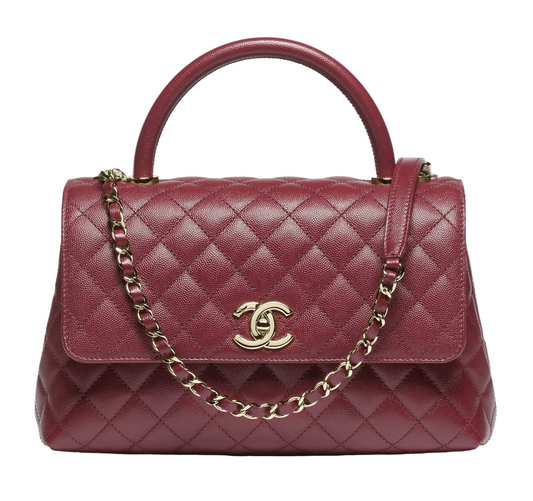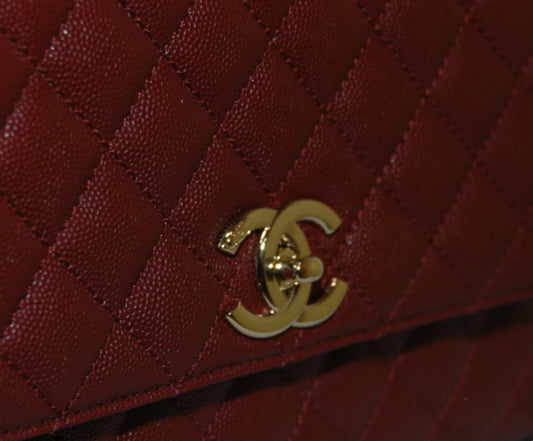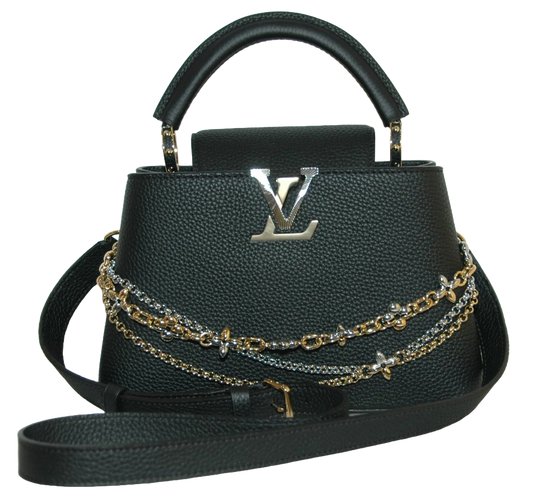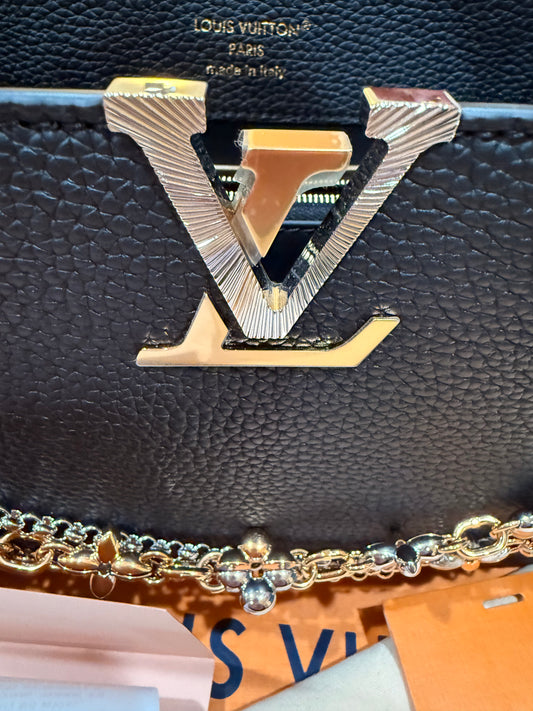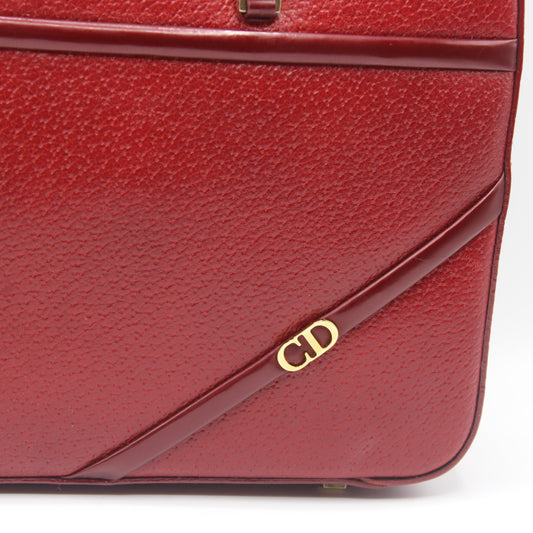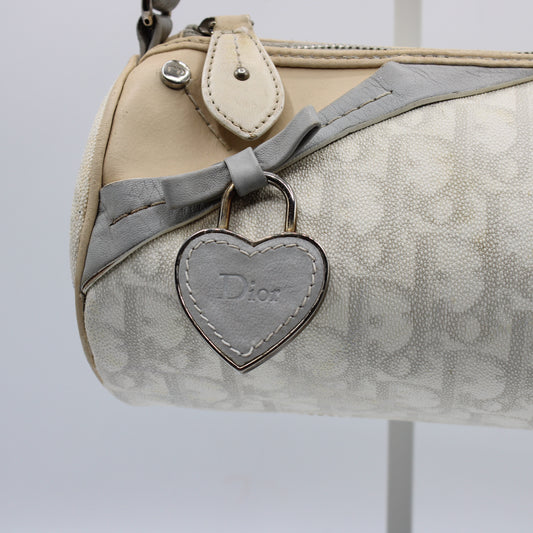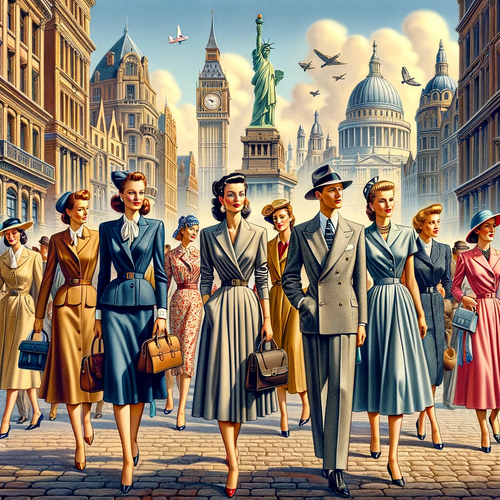
Resilience in Style: 1940s Fashion's Influence on Dior, Fendi, Gucci, Chanel
Stefany BagsShare
At Stefany Bags Shoes and More, we appreciate the profound influence of history on fashion. The 1940s stand as a testament to this, a decade where the world of fashion underwent a seismic shift. This era, marked indelibly by World War II, saw dramatic changes in style, materials, and the very essence of luxury. As the world grappled with unprecedented challenges, the fashion industry mirrored these shifts. It was a time of resource scarcity and practicality, yet it also birthed an era of creativity and innovation that would leave a lasting imprint on luxury fashion.
In the midst of this turbulent period, four iconic fashion houses - Christian Dior, Fendi, Gucci, and Chanel - emerged not just as survivors but as trendsetters. Each of these brands, with their unique styles and visions, navigated the war's constraints and post-war recovery, leaving an indelible mark on the fashion landscape. Their stories of resilience, adaptability, and creative ingenuity during these trying times are a source of inspiration for us at Stefany Bags Shoes and More, reflecting our commitment to elegance and quality in every product we offer.
The 1940s fashion landscape, as featured on Stefany Bags Shoes and More, was a canvas of contrasts and adaptations, reflecting the tumultuous times of the era. As World War II raged, fashion took a utilitarian turn, with practicality and resource conservation overshadowing the extravagance of previous years. Women's clothing, in particular, underwent significant transformation. The silhouettes became more streamlined and functional, with shorter hemlines and simpler cuts becoming the norm. This was not just a style statement but a necessity, as fabric rationing limited the amount of material that could be used for each garment. Utility clothing, with minimal embellishment and made from durable fabrics, became widespread.
Men's fashion too mirrored these practical concerns. The classic suits of the era were more austere, with narrower lapels and a leaner cut, conserving fabric without compromising on professionalism. Military uniforms, worn by millions, also influenced civilian fashion, introducing features like shoulder pads and a more structured appearance that would linger long after the war.
The scarcity of materials spurred an era of innovation. With traditional fabrics like silk and wool in short supply, fashion designers and manufacturers turned to unconventional materials. Rayon, a versatile and more affordable fabric, gained popularity. This period also saw the introduction of synthetic fabrics, a move that would have a lasting impact on the fashion industry.
In this challenging environment, creativity flourished. Designers and home seamstresses alike began upcycling older garments, transforming them into new styles. This resourcefulness not only showcased the resilience of the fashion industry but also set the stage for a more sustainable approach to clothing, a concept that resonates with the ethos of Stefany Bags Shoes and More.
Christian Dior's Revolutionary "New Look"
The post-war era witnessed a revolutionary shift in fashion, epitomized by Christian Dior's groundbreaking "New Look." Unveiled in 1947, this style marked a dramatic departure from the austerity and practicality that dominated wartime fashion. Dior's New Look redefined femininity with its emphasis on opulence and shape, offering a stark contrast to the previous decade's utilitarian simplicity.
Dior's vision manifested in flowing skirts that used yards of fabric, a stark contrast to the fabric-conserving styles of the war years. The silhouette was characterized by a cinched waist, accentuating the bust and hips, and creating an hourglass figure that was a deliberate nod to classical femininity. This new aesthetic was not just a change in style; it was a bold statement of renewal and a return to luxury after years of restrictions. The New Look was about reclaiming the joy and artistry of fashion, a celebration of abundance and beauty in the post-war world.
Alongside these striking garments, the importance of accessories, particularly handbags, was elevated. Dior recognized that a bag was not just a functional item but an integral part of a woman's ensemble. Handbags designed in this era complemented the New Look's elegance, often featuring luxurious materials and refined details. These bags were not mere accessories; they were symbols of a woman's style and status, embodying the same principles of luxury and femininity that defined Dior's clothing.
Christian Dior's New Look was a watershed moment in fashion history. It represented more than just a new style; it was a cultural shift. After years of hardship, this new opulence in fashion allowed women to express themselves and their aspirations for a brighter, more prosperous future. It was a celebration of beauty and a definitive step towards the modern fashion era, an era where the harmony of garments and accessories like handbags became essential to the expression of personal style.
Fendi's Adaptation and Survival in the 1940s
During the 1940s, Fendi, a nascent name in the world of luxury fashion, faced immense challenges due to the material shortages and economic difficulties of the war era. Yet, it was during this time that Fendi's enduring legacy of adaptability and exceptional craftsmanship began to take shape, laying the foundation for its future as a powerhouse in luxury fashion and, notably, in the world of designer handbags.
Founded in 1925 in Rome, Fendi was initially a fur and leather shop. The 1940s compelled the brand to navigate a landscape where traditional luxury materials were scarce. Resourcefully, Fendi began experimenting with alternative materials and techniques, a move that not only kept the brand afloat but also showcased their commitment to innovation and quality. This period was crucial in shaping Fendi's identity; it emphasized their ability to blend creativity with craftsmanship, a trait that would become synonymous with their brand.
In the realm of handbags, Fendi's response to the material shortages was particularly noteworthy. The brand started experimenting with different types of leathers and skins, often utilizing less conventional ones that were more readily available. They also began to introduce bags that were smaller in size, a practical response to material limitations, but without compromising on style and elegance. These handbags were meticulously crafted, ensuring that each piece embodied the luxury and quality that Fendi stood for, despite the challenging circumstances.
This era also saw Fendi placing a greater emphasis on detailed craftsmanship. Every stitch and seam was a testament to their artisans' skills, an attribute that would become a hallmark of Fendi handbags. Their ability to maintain high-quality products during such times not only helped them survive the war but also cemented their reputation as a brand synonymous with durability, luxury, and timeless style.
Fendi's journey through the 1940s is a compelling story of resilience and adaptability. In the face of adversity, the brand not only managed to survive but also laid down the principles of innovation and craftsmanship that continue to define their luxurious handbags and fashion products.
Gucci's Ingenuity Amidst Adversity in the 1940s
Gucci's journey through the 1940s is a remarkable tale of ingenuity amidst adversity, a narrative that profoundly shaped the brand's identity and its approach to luxury fashion and handbag design. Founded in 1921 by Guccio Gucci, the brand initially gained recognition for its fine leather goods. However, the onset of World War II posed significant challenges, as leather and other standard materials became scarce due to wartime constraints.
In response to these challenges, Gucci showcased remarkable creativity and resourcefulness. The brand began experimenting with alternative materials, leading to some of its most iconic designs. One of the most notable innovations was the introduction of bamboo. Bamboo, which was relatively abundant compared to other materials, was used to create the handles of handbags. This not only solved a practical problem but also resulted in a distinctive aesthetic that became a signature of Gucci's handbags.
Another significant adaptation was the use of canvas. Gucci developed a unique canvas fabric, distinguished by its durability and luxury appeal. The canvas was often adorned with the now-iconic double-G logo and a distinctive red and green stripe, embodying the brand's heritage. These canvas bags were not just a response to material scarcity; they represented a new direction in luxury fashion, where practicality met elegance.
These innovations were pivotal in defining Gucci's style during and after the war. The bamboo-handled bags, in particular, became synonymous with the brand, showcasing Gucci's ability to transform a simple, functional item into a symbol of luxury. Similarly, the use of canvas in handbags was a testament to Gucci's adaptability, proving that luxury is not solely defined by traditional materials but also by craftsmanship and design.
The ingenuity Gucci displayed during the 1940s set a precedent for the brand's future endeavors. Their ability to innovate within constraints not only helped them navigate through the challenging war years but also laid the groundwork for their enduring status as a purveyor of luxury and style. Gucci's approach during this era is a powerful reminder that creativity and resilience can turn challenges into opportunities for growth and evolution in the world of luxury fashion and accessories.
Chanel's War-Time Hiatus and Its Lasting Impact
The narrative of Chanel during the 1940s is one marked by a dramatic hiatus, profound influence, and a notable resurgence. As World War II engulfed Paris, the epicenter of fashion, Chanel, under the direction of its iconic founder, Coco Chanel, made the significant decision to close its doors. This closure was not just a response to the war but also a reflection of the tumultuous and complex socio-political landscape of Paris under Nazi occupation.
Chanel's closure during the war had a considerable impact on the fashion world. At a time when Parisian fashion was at its most influential, the absence of Chanel, a brand synonymous with luxury and elegance, was keenly felt. However, the legacy of Chanel's pre-war designs continued to wield significant influence. The brand's emphasis on simplicity, comfort, and elegance resonated strongly with the practical needs of the war era. Elements like the Chanel suit and the little black dress, both hallmarks of Chanel's earlier collections, remained style staples, their enduring appeal a testament to the brand's lasting impact on women's fashion.
Interestingly, the war years also saw an evolution in handbag styles in Paris, with practicality becoming a key consideration. The designs during this time leaned towards functional and sturdy bags, often with simpler forms and less ornamentation, reflecting the austere conditions of the period. While Chanel was not active during these years, the brand's pre-war focus on functionality, as seen in their early handbag designs, aligned well with this trend.
The post-war period marked a significant resurgence for Chanel. In 1954, Coco Chanel reopened her fashion house, and this comeback was met with enthusiasm and acclaim. This era saw Chanel introducing new designs while also revisiting and refining their classic elements. The brand's revival post-war played a crucial role in shaping its future collections, reintroducing its timeless elegance to a new generation and reinforcing its status as a pillar of luxury fashion. This resurgence also marked the introduction of new handbag styles, which would go on to become iconic in their own right, encapsulating the essence of Chanel's blend of luxury, elegance, and practicality.
The 1940s, a decade of resilience and ingenuity for the fashion world, profoundly influenced the trajectory of luxury fashion. Fashion houses like Dior, Fendi, Gucci, and Chanel demonstrated remarkable creativity and adaptability in the face of adversity, setting new standards in style and craftsmanship. Their ability to innovate, whether through Dior's New Look, Fendi's material experimentation, Gucci's iconic bamboo handles, or Chanel's timeless elegance, not only helped them survive the challenging war years but also defined the future of luxury fashion.
This era's impact extends significantly into the realm of vintage handbags, which are now treasured as rare historical artifacts. The scarcity of these vintage bags from the 1940s, owing to their age and the circumstances of their creation, has only added to their allure and value. They are not just accessories but symbols of a defining era in fashion history, embodying the enduring legacy of these iconic brands.
At Stefany Bags Shoes and More, these historical insights resonate deeply. They inspire our collections, reminding us of the timeless elegance and enduring quality that define luxury fashion. As we curate our selections, we are reminded of the innovation and resilience embodied by these vintage pieces, striving to bring a piece of this rich history to our customers through our products.
© 2024 Stefany Bags Shoes and More

